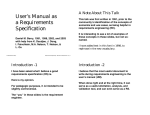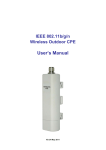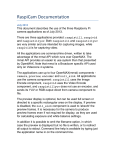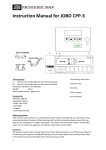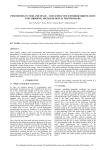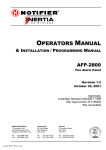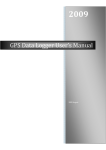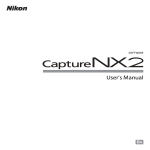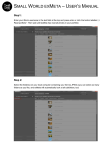Download User Guide - B&H Photo Video
Transcript
User Guide Version 1.3 -1- Content 1. Introduction..................................................................................................3 2. Quick Start Guide ...........................................................................................3 3. photoGPS ......................................................................................................3 4. photoGPS Software Installation ........................................................................4 5. Preparing to use photoGPS ..............................................................................4 6. Capturing Locations with photoGPS...................................................................5 7. Geotagging with photoGPS ..............................................................................6 8. Modifying the Location Data ............................................................................9 9. Configuring the POI Search............................................................................ 11 10. Managing GPS Captures ............................................................................... 12 11. Photo Metadata Options .............................................................................. 13 12. Language Selection..................................................................................... 14 13. Internet Connection Options ........................................................................ 14 14. Emergency Reset ........................................................................................ 14 15. Emergency Erase......................................................................................... 15 16. Capture Delay Setting.................................................................................. 15 17. Metadata Description .................................................................................. 16 18. Troubleshooting ......................................................................................... 19 19. Contact/Service.......................................................................................... 20 -2- 1. Introduction Thank you for purchasing the JOBO photoGPS geotagging solution. The photoGPS enables easy geotagging of photographs by connecting to your camera's hot shoe. This guide explains how to set the device up ready for use, and how to use the photoGPS and software to geotag your photos. For further information please visit www.JOBO.com 2. Quick Start Guide 1. Insert the CD included in the photoGPS package. The CD will start automatically and launch your default browser and open a local webpage. Press the button “Installer photoGPS” and install the photoGPS software. 2. Run the photoGPS application. Note that your computer must be connected to the internet to allow the software to properly configure the photoGPS for the first time. 3. Charge the photoGPS by connecting it to your computer using the supplied USB cable. It can take up to two hours to fully charge the device, but five minutes is enough for a first quick test. 4. Attach the photoGPS to your camera hot shoe 5. Go outside and take photographs 6. Offload the photographs from your camera to a computer 7. Connect the photoGPS to your computer 8. Run the photoGPS application 9. Press the ‘Import GPS Captures’ button 10. Select the source folder containing your photos 11. When the download and processing of your GPS captures are completed, then press the ‘Match Photos’ button 12. If necessary, edit the photo location information (for more details, see section 6) 13. Press the ‘Tag Photos’ button to create your geotagged photos 14. View, edit, share etc. your geotagged photos in Picasa, Microsoft Pro Photo Tools, Flickr etc. 3. photoGPS USB 2.0 connector Geohint Button -3- 4. photoGPS Software Installation Insert the CD included in the photoGPS package. The CD will start automatically and launch your default browser and open a local webpage. Press the button “Installer photoGPS” and follow the instruction to begin installation of the photoGPS software. Accept the terms of the end-user license and follow the prompts to perform a ‘Complete’ install of the software. During the installation you will be prompted to connect your photoGPS to the computer via the supplied USB cable. If your computer is using a proxy server to connect to the internet you may get an error message indicating a ‘problem downloading photoGPS.msi’. This is because some proxy servers may be configured to block the download of .MSI files and these are needed for the photoGPS installer. To try to resolve this problem, you can temporarily disable use of the proxy: 1. Open Internet Explorer 2. Select Tools > Internet Options... to open the Internet Options dialog 3. Select the Connections tab and then click the LAN Settings... button 4. Make a note of the current settings and then uncheck all the following check boxes: Automatically detect settings Use automatic configuration script Use proxy server for your LAN 5. Click OK to save these settings and click OK to close the Internet Options dialog 6. Run the installer again (or click Retry in the error dialog), it should now successfully download the MSI file and install the application 7. Once the installer has successfully completed, open the Internet Options dialog again and revert any changes made to the previous settings 5. Preparing to use photoGPS Before using your photoGPS for the first time, some preparation is required. To begin, you must run the photoGPS application software. Under Windows XP, for example, click the Start button and select All Programs -> JOBO -> photoGPS -> photoGPS. After a few seconds the photoGPS application window will appear. Note that, to use most of the features of the photoGPS application your computer must be connected to the internet. First, connect the photoGPS to the computer using the supplied USB cable. The Capture Device Tab is at the top left hand corner of the application. You should see the status message change from No Device Found to Device Connected. The photoGPS has an internal clock, which must be set correctly for the device to function. This clock is set automatically when the device is plugged in and the photoGPS application is running. -4- You can check that it has been set correctly by looking at the device configuration window, which is accessed by pressing the ‘Configure Device’ button. (Note: photoGPS time is UTC, not local time.) The photoGPS contains a rechargeable battery, which is charged simply by connecting the device to a USB port. When connected, a constant red status LED indicates ‘charging’ and a constant green status LED indicates ‘fully charged’. The charging status is also indicated in the photoGPS configuration window. Ideally, you should fully charge the photoGPS before using it. This should take no longer than a couple of hours. Once you have checked that your device has been charged, and its clock is set, you are ready to test the device. Please follow these steps to confirm that everything is working before going out and using your device: 1. Place the photoGPS onto the camera's hot shoe 2. Take a picture, whilst observing the photoGPS LEDs. When the shutter is pressed the LED light should flash green once. If this is the case, you are now ready to go outside and start taking geotagged photographs. If not, consult the Troubleshooting section. 6. Capturing Locations with photoGPS Your photoGPS is extremely easy to use. Simply connect it to your camera via the hot shoe and take photos as normal. Each time you take a photo, the green status LED should flash once as the device captures GPS data for the current location. If this is not the case, consult the Troubleshooting section at the end of this guide. The photoGPS works by receiving GPS signals transmitted by satellites and therefore needs a good view of the sky to function well. So, if possible, try to avoid taking photos next to walls, when surrounded by tall buildings or indoors etc. Of course, this is not always possible and sometimes you will want to take geotagged photos in areas where there is poor GPS reception e.g. indoors. The JOBO photoGPS solution allows you to do this. Simply press the device GeoHint button before you enter such an area and it will capture the location. This can be used later, by the photoGPS software, as a hint to help geotag photos taken inside the area of poor GPS reception. If you forget to press the GeoHint button before entering the area, no problem, pressing the button after leaving the area will work just as well. If you forget to press the GeoHint button at all, the photoGPS software will still try to geotag your photos based on the positions of any earlier/later photos and/or GeoHints. An alternative to the GeoHint button is simply to take a photograph (with the photoGPS on the camera) either before entering or after leaving the area of poor GPS reception. The disadvantage of this approach is that you may have to take a photo that you don’t really want in order to geotag those that you do. For the best results it is advisable to keep the photoGPS connected to the camera for all photos you wish to geotag. However, if this is not possible (e.g. the hot shoe is required for an external flash) then the device can be removed temporarily. The photoGPS software will still try to geotag your photos based on based on the positions of any earlier/later photos and/or GeoHints. Tip: If you wish to take geotagged photos in an area of poor GPS reception, it may be better to use the GeoHint button, as described, and remove the photoGPS from the camera when taking photos in -5- the area. This may improve the speed of the photoGPS software as it will not have to spend time trying to determine locations from the captures taken in difficult conditions. Your photoGPS can store approximately 1000 GPS data captures. The device will indicate when it is becoming full, by flashing the red status LED immediately after the green status LED when taking a capture. When this first happens, you still have about 200 captures remaining, but you will soon need to connect the photoGPS to a computer to offload/delete the current captures to make room for more. Tip: One of the advantages of the photoGPS solution is that there is no need to synchronise the time of the device with the time on your camera. This is due to the fact that the photoGPS matching algorithm uses time intervals rather than absolute times. However, this approach does mean that the camera clock must stay the same for all photos in a batch to be geotagged. The camera time can be changed between batches of photos, if required e.g. to set the local time for a set of photos taken on holiday. 7. Geotagging with photoGPS Geotagging your photos is simple, using the photoGPS software. To begin, download the photos from your camera onto your computer. Next, connect your photoGPS to the computer via USB and run the application software. The photoGPS application main window is split in half. On the left hand side is the GPS data pane, which is used to configure your photoGPS, to transfer/delete the GPS data captures from the device and to show the resulting location information. On the right hand side is the Photos Pane, which is used to select the source (original images) and destination folders (tagged images) and to display/edit the location information for each image. GPS Data Pane Photos Pane There are a number of options and settings that control the operation of the photoGPS software. These are explained later in this guide, but here we describe the simplest workflow using the default options. -6- 1. Press the ‘Import GPS Captures’ button on the Capture Device tab. The GPS captures will be downloaded from the device and processed to determine their locations. When this is successful, the resulting GPS position fix information is displayed in green (time/latitude/longitude/altitude). Failed fixes are shown in red. The photoGPS software will perform several passes, retrying the captures that originally produced failed fixes, as these can sometimes be turned into successful fixes by using information from other fixes. In addition, the application performs reverse geocoding, to try to provide an address for each capture (street/town/country). 2. In the Photos Pane, select the source folder containing the photos you just offloaded from your camera. The photos will be loaded and their thumbnails displayed. By default, the same directory is used to store the geotagged photos. JPEGs are overwritten with geotagged versions and RAW photos are given an XMP sidecar. If you prefer, you can select an alternative destination folder for the geotagged photos. -7- 3. Once all of the GPS captures have been processed and your photos have loaded, press the ‘Match Photos’ button to automatically assign the location information from the GPS pane to the photographs. In addition to the address, each matched photo will also show a list of nearby points of interest (POIs). -8- 4. If you are not satisfied with the location information which has been automatically assigned to each photo, there are a number of ways you can make changes. These are described in the following section. Double-click on a photo to see a larger view and more details. 5. When you are satisfied that the location information for each photo is correct, press the ‘Tag Photos’ button to save your geotagged images. 6. If you have more photos to geotag you can select another photo source folder and repeat the process. Otherwise, you can exit the photoGPS application. Before doing so you may wish to access the ‘Device Configuration’ window to erase the GPS captures from the photoGPS. 7. Finally, you can load the geotagged images into a geo-aware application, such as Picasa, Flickr, etc. to search/organise using the location information, display them on a map etc. After tagging is completed, the photoGPS software creates a file called Photos.KML in the destination directory. If you have Google Earth installed on your computer, you can double click on this file to see your geotagged photos on a map of the world. 8. Modifying the Location Data When the matching process is complete, if you are not satisfied by the location information (address and POIs) which has been automatically assigned to your photos, there are a number of ways you can make changes. -9- The first possibility is that one or more of your photos have been assigned location information from the ‘wrong’ GPS data capture, or perhaps have not been assigned any location information at all. In such cases you can copy/paste or drag/drop location information from one photo or GPS data capture to one or more photos. The table below describes the various actions that can be performed. Note: all of the usual windows short cut keys (such as Ctrl-V for paste, Del for Delete etc.) are available if you wish to use them. Action Desired Copy location of one Photo (or GPS capture) to another What you need to do Result Drag and drop in the usual way Copy location of one Photo (or GPS capture) to many others Right click on the photo (or GPS capture), select copy from the menu. Select the photos to which you wish to copy the location using the mouse. Right click the mouse button when over one of the selected photos and select paste from the menu Select one or more photos. Right click the mouse and select delete from the menu. Location of the initially selected photo (or GPS capture) is copied to the photo into which it is dropped The selected photos are given the same location as the initial copied photo location (or GPS capture) Delete location from a photo or photos Undo the previous copy location operation Right click the mouse anywhere in the photos area and select Undo Paste Location from the menu The locations and points of interest will be deleted from the photos selected The previous location(s) are restored Photos which have automatically assigned location data are flagged with a blue pin which have had their location data edited are flagged with a red pin . . Photos The second possibility is that photoGPS has been unable to automatically determine the correct address and/or nearby POIs for one or more of your photos. In this case, you can manually edit the information. Simply double click on a photo to show more details. In the detailed view you can edit the address and existing POIs and/or add new POIs. Press ‘OK’ to save the new location information, which can then be copied to other photos if required, as above. - 10 - The final possibility is to modify the POI search parameters (described in the next section) to see if photoGPS can automaticaslly provide a better list of POIs for each photo. 9. Configuring the POI Search The POI search parameters can be controlled via the photoGPS application options screen, which is under the menu item Tools->Options and then select the “Points of Interest” tab. POIs are separated into a number of categories e.g. Tourist Attraction, Food & Drink etc. By default all categories are searched, but this can be limited by removing the tick from the appropriate checkbox. photoGPS searches for POIs in an area centred on the photo location. The radius of this area can be selected from 100m to 5km. It is also possible to change the limit for the number of POIs returned by the search function (maximum 20). Ideally, these POI search parameters should be set when photoGPS is started, before loading any GPS captures. However, the parameters can also be modified after the matching step. In this case the POI search will be redone (which can take some time) and the new POI results will be assigned to the photos. - 11 - 10. Managing GPS Captures When the device is connected to the computer, the photoGPS software displays the number of captures currently stored on the device and the percentage of the total storage used. The same information is accessible by pressing the ‘Configure Device’ button. This pops up a window which includes a graphical display of the number of captures used and an estimate for the number of captures remaining. The battery status, device identifier, firmware version and internal clock time are also shown. This window has an ‘Erase All Data’ button, which can be used to delete all the captures from the device when they are no longer needed. The typical workflow is to geotag your photos, as described earlier in the guide, then use this button to delete the captures from the device ready to start taking new photos. If you want to archive your GPS capture data you can bring up the ‘Options’ window (via the Tools -> Options menu) and select the ‘GPS Data’ tab. Here you can choose a folder that captures will be copied to when importing from the device. - 12 - By default, this option will not automatically delete captures from the device; you will need to do this using the ‘Erase All Data’ button, if required. However, you can change this by ticking the ‘Auto Erase on Import’ checkbox, which is accessed via the ‘Advanced Settings’ button in the device window. It may be that your photoGPS is becoming full but you are unable to geotag your photos and delete the GPS data captures because you do not have internet access. In this case you can use the Tools > Download Data menu item to save the captures to your computer without trying to process them to obtain position information. The saved captures can then be erased from the photoGPS and a new set of photos/captures taken. To use the saved GPS data captures for geotagging, instead of the ones on the photoGPS, simply select the ‘Import From Folder’ tab in the GPS Data Pane, choose the desired folder and press the ‘Import GPS captures’ button. 11. Photo Metadata Options Select the Tools -> Options menu item and then click the ‘Photos’ tab, to set the photo metadata options. By default, photoGPS writes location metadata into XMP sidecars for RAW images, but embeds it directly into JPEG image files. - 13 - This tab also allows for a custom copyright message to be specified. If the checkbox is ticked, this copyright message will automatically be added to the Copyright field of all geotagged photos. 12. Language Selection The Tools -> Language menu option allows the user to change the language used by the photoGPS user interface. Supported languages are: English, German, French, Italian and Spanish. 13. Internet Connection Options In order to generate location information from the GPS data captures, the photoGPS software needs to be able to communicate with our internet servers. This may not be possible if your computer is using a proxy system, which is common for many businesses. If this is the case, select the Tools -> Options menu item and then click the ‘Server Connection tab. Then tick the ‘Use HTTP Proxy Server’ checkbox and enter the Server and Port details. 14. Emergency Reset In the unlikely event that your photoGPS is not functioning correctly, read through the Troubleshooting section of this guide to try and discover the cause of the problem. If all else fails you can reset the photoGPS using the reset button. This is located behind a small hole in the bottom of the device casing, close to the hot shoe connector and red status LED. To reset the device simply insert e.g. a bent paperclip into the hole and push until the reset button is depressed, then release. Note, you cannot reset while the device is connected via USB. USB 2.0 connector - 14 - Geohint Button 15. Emergency Erase The photoGPS has an emergency erase function, which can be used to delete all the currently stored captures. This may be useful if, for example, you are away from your computer and realize that you did not erase the captures after your last geotagging session. Or the photoGPS may be running out of space and you want to sacrifice the current stored captures to allow new ones to be created. Please use this function with care. If you have not previously stored the captures then they will be lost forever and cannot be used to geotag your photos. To perform an emergency erase: - - disconnect the PhotoGPS from the computer press and hold the Reset button, as above simultaneously, press and hold the GeoHint button release the reset button (continue to hold the GeoHint button the red status LED should flash four times, if so you can release the GeoHint button, if not, repeat the process again wait for the green status LED to flash twice all the captures have now been erased and the photoGPS is ready for use 16. Capture Delay Setting Some cameras generate a lot of electromagnetic interference, which can affect the performance of the photoGPS. Typically, this interference is worst when the camera is taking a photo. For this reason, the photoGPS does not take a capture at exactly the same time as the camera shutter is pressed. Instead, there is a short delay before taking the capture, to avoid the worst of the camera interference. The default delay is approximately one second. However, every camera is different and there is no universal best delay setting. Even for a single camera, the interference effects may change according to e.g. the shooting mode, image size, flash card speed etc. If you find that your photoGPS gives consistently poor results, even with a clear view of the sky, then it may be worth trying different delay settings. To change the default capture delay, connect the device to your computer and run the photoGPS software. Next press the ‘Configure Device’ button and then the ‘Advanced Settings’ button in the device window. Now select one of the delay settings. You can choose various settings from zero to three seconds. If problems persist, please contact JOBO and provide details on your camera make and model. - 15 - 17. Metadata Description Every digital photo contains extra information, known as metadata. Some metadata is always written to the file which contains the image data. Further information may be stored in an associated file, known as a "sidecar". For JPEG files, the metadata is usually stored in the file itself. (Note that image data and metadata are kept apart in JPEG files, so that each can be updated without interfering with the other. On the other hand, camera "RAW" images are not intended to be updated, so the metadata is held in a sidecars. When the camera takes a photo, it writes some metadata into the file which contains the image. This will include the date and time when the photo was taken and, typically, other information about the image such as camera settings and exposure time. When the photos are geotagged, the photoGPS software writes geographical metadata to the image or its sidecar file. The photoGPS software works with four different metadata types: IPTC (International Press Telecommunications Council). This is an older meta information format and the information is gradually migrating to XMP. IPTC tags hold information relating to the photographer (e.g. copyright, contact details) and information on the subject of the image (e.g. location, keywords etc.). XMP (Extensible Metadata Platform). This is an open XML-based metadata format created by Adobe. Typically, it duplicates (and extends) the IPTC information. photoGPS also use XMP to store the Points of Interest (POI) data. Windows (Microsoft Windows file properties). photoGPS sets a number of Windows XP/Vista file properties such as Title, Subject and Keywords. There are 3 categories of photoGPS metadata GPS - the date, time and position (latitude,longitude and altitude) of the photoGPS when the photo was taken. Reverse Geocoding - the address corresponding to the GPS position. This comprises 4 lines: 3 address lines and the Country, e.g. "Redcoat Lane, Weybridge, Surrey, England". Note that in the descriptions below, the 4 lines are represented as: <Address Line 1>, <Address Line 2>, <Address Line 3> and <Country> POIs - a list of points of interest, written as a string containing delimiters to separate each POI and the fields within it. The full list of metadata tags written by photoGPS is as follows: The values for these 2 tags are fixed: EXIF:GPSVersionID 2200 EXIF:GPSMapDatum WGS-84 The values shown here are examples. EXIF:GPSLatitudeRef EXIF:GPSLatitude N 51.5120877998972 - 16 - EXIF:GPSLongitudeRef W EXIF:GPSLongitude 0.1100752 EXIF:GPSAltitudeRef 0 EXIF:GPSAltitude 31 EXIF:GPSTimeStamp 13:49:15 EXIF:GPSDateStamp 2008:09:13 For sidecar files which only contain XMP, the same information is written to a slightly different set of tags. Latitude and longitude are written as signed values (rather than with a separate "ref" tag denoting E/W and N/S). Date and time are combined into a single tag which holds both values: XMP:GPSLatitude -4.743 XMP:GPSLongitude -2.607 XMP:GPSDateTime 2008:05:14 11:06:28 IPTC:Sub-location <Address Line 1> XMP-iptcCore:Location <Address Line 1> IPTC:City <Address Line 2> XMP-photoshop:City <Address Line 2> IPTC:Province-State <Address Line 3> XMP-photoshop:State <Address Line 3> IPTC:Country-PrimaryLocationName <Country> XMP-photoshop:Country <Country> <Address Line 1> + <Address Line 2> + <Address Line 3> + <Country> <Address Line 1> + <Address Line 2> + <Address Line 3> + <Country> <Address Line 1> + <Address Line 2> + <Address Line 3> + <Country> XMP:Subject IPTC:keywords IPTC:Caption-Abstract EXIF:Copyright <Copyright> IPTC:CopyrightNotice <Copyright> Although not in the official specification, there are EXIF tags (generally referred to as "XP..." or "XP_...") that hold the information which is shown as file attributes on Windows XP. EXIF:XPTitle EXIF:XPKeywords <Address Line 1> + <Address Line 2> + <Address Line 3> + <Country> <Address Line 1> + <Address Line 2> - 17 - + <Address Line 3> + <Country> <Address Line 1> + <Address Line 2> + <Address Line 3> + <Country> EXIF:XPSubject Special JOBO tags These are custom tags defined to hold reverse geocoding and POI information. XMP-Geotate:GeotateGRL <GRL> XMP-Geotate:GeotateRGCVersion 1.0 These are used internally by photoGPS XMP-Geotate:GeotatePOI <POI>,<POI>,... Where <POI> is name>|<category_type>|<distance>|<lat>|<lon> and <name> is the name of the POI, <category_type> is the name of the photoGPS POI category e.g. "Beach", "Food&Drink" etc. Note: the language used will be the current photoGPS application language as set by the user. <distance> is the distance in metres to the POI <lat> and <lon> are the latitude and longitude of the POI. e.g. "Nigerian High Commission|”Government”|237.0|51.513|-0.108, Starbucks Coffee|”Food&Drink”|231.0|51.513|-0.110" Finally, the reverse geocoding and POI information is also written to the IPTC Keywords tag: IPTC:Keywords <Address Line 1> + <Address Line 2> + <Address Line 3> + <Country> + <POI1> + <POI2> + ... th where <POIn> is the n POI, formatted as <name>(<category_type>) e.g. "Nigerian High Commission (Government)” or “Starbucks Coffee (Food&Drink)" - 18 - 18. Troubleshooting - Problem: the photoGPS does not produce a single green LED flash when taking captures/photos - Answer: When attempting to capture a location, the photoGPS will flash its LEDs to indicate the result of the capture. The table below shows what these flashes mean. Each letter indicates a flash of either red (R) or green (G). LED Flashes Meaning Action Required G None (when taking a photo) Capture successful Either the device is not properly attached to the hot shoe or there is a triggering problem None (when pressing the GeoHint button) GR It is likely that the photoGPS battery is flat None Try removing the photoGPS from the camera hot shoe and reattaching. If this does not help consult the ‘photoGPS does not trigger’ section below Recharge the photoGPS via USB. Capture successful, but getting low on battery or memory (<20%) GRR Capture aborted due to error GRRRR Out of memory GRRRRRRRR Device clock not set RRRR pause GG Flashing Red Reset /clear started … and completed Device failure If you think the battery may be low, recharge by connecting to a computer using the UB cable. If the device is becoming full, either process and delete the captures as normal or offload the captures for later processing. Retry. If the problem persists, contact Jobo. Either process and delete the captures as normal or offload the captures for later processing. To set the clock automatically, connect the device to a computer and run the photoGPS application (whilst connected to the internet) Continue to use Contact Jobo Problem: When connected to the camera via the hot shoe, the photoGPS is not activated when a photo is taken Answer: For the photoGPS to function, it must receive a trigger from the camera via the centre pin of the hot shoe. If this is not happening, usually the problem is that the device is not properly connected to the hot shoe. Try removing and replacing the device and check the device is making contact with the hot shoe centre pin. Another possibility is that the device is properly attached but the camera is not triggering the hot shoe. Most cameras will do this without any problem, using their default modes and settings. However, a small number of cameras may only trigger the hot shoe in certain modes or after changing certain settings. For example, some cameras, in Automatic mode, will not trigger the hot shoe at all, or only in certain lighting conditions. In such cases, try one of the other modes (Shutter priority, Manual etc). Some cameras, by default, have the hot shoe (external flash) turned off. Typically this is easily solved by changing the appropriate camera menu setting. Please consult your camera manual for information. If you have an external flash device - 19 - available, a useful test is to check if this is triggered by your camera. If you find that your camera refuses to trigger the photoGPS, contact JOBO with details of your camera make and model. Problem: the photoGPS software is showing a “Communications Error” message. Answer: The photoGPS software needs a reliable internet connection in order to process the GPS captures to obtain location information. If you see this message, check that your internet connection is working, then press the “Retry” button. If this works, the problem is probably due to an intermittent network connection. Another possibility is that you are using a proxy server to connect to the internet. If this is the case you should follow the instructions in the section on ‘Internet Connection Options’ to configure the photoGPS software to use your proxy. A related problem can occur in Microsoft Windows, if the user’s home directory is on a network drive. If the local network has a problem, the home directory can ‘disappear’, which may cause photoGPS to behave erratically. Problem: Photos are not displayed in Google Earth when viewing the Photos.KML file produce by the photoGPS software. Answer: Google Earth does not support RAW photos. If you are using RAW, you will still see the positions of the photos in Google Earth, but you will not be able to see the photos themselves. 19. Contact/Service If you have any questions on or need help with our products please do not hesitate to get in touch with our Technical Service. You can reach our service people by phone under the telephone number indicated below from Monday through Thursday from 9:00 am to 4:00 pm and on Friday from 9:00 am to 1:00 pm. Independently of these service times you can also get in touch by e-mail, fax or mail: JOBO AG Koelner Strasse 58 D-51645 Gummersbach, Germany Tel. 0049 2261 545-72 Fax: 0049 2261 545-42 E-mail: [email protected] www.jobo.com - 20 -




















